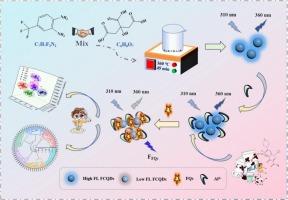基于氟掺杂碳量子点和机器学习的氟-氟相互作用机制在氟喹诺酮类抗生素识别和环丙沙星检测中的探索
IF 9.8
1区 农林科学
Q1 CHEMISTRY, APPLIED
引用次数: 0
摘要
不加控制地使用抗生素对人类健康和生态系统构成重大威胁。食品中氟喹诺酮类抗生素的准确鉴别和微量检测势在必行。制备了Al3+螯合氟掺杂碳量子点(FCQDs-Al3 +),设计了用于检测牛奶中环丙沙星(CIP)的比例荧光传感器。fqds在360 nm处的荧光被CIP猝灭,在430 nm处被CIP与Al3+螯合增强。该传感器的检出限为4.20 nM,加标回收率为96.32 % ~ 100.07 %。机器学习方法确定了FF相互作用导致的猝灭机制,建立了6种FQs的识别模型。因此,氟喹诺酮类抗生素的检测可以先定性后定量。所开发的传感器对其他5个FQs有很好的定量结果。该方法在FQs的鉴定和检测方面具有很大的潜力。本文章由计算机程序翻译,如有差异,请以英文原文为准。


Exploration of the fluorine−fluorine interaction mechanism in fluoroquinolone antibiotics recognition and ciprofloxacin detection on the basis of fluorine−doped carbon quantum dots and machine learning
The uncontrolled use of antibiotics poses a significant threat to human health and ecosystems. Accurate differentiation and trace detection of fluoroquinolone antibiotics (FQs) in foods are imperative. Fluorine–doped carbon quantum dots chelated with Al3+ (FCQDs–Al3+) was prepared to design a ratiometric fluorescence sensor for the detection of ciprofloxacin (CIP) in milk. The fluorescence of the FCQDs at 360 nm was quenched by CIP and enhanced at 430 nm by CIP chelation with Al3+. The limit of detection of the sensor was 4.20 nM, and the spiked recovery rates in milk samples were 96.32 %–100.07 %. Machine learning methods confirmed quenching mechanism caused by the F![]() F interaction and established identification models of six FQs. Therefore, fluoroquinolone antibiotics detection can be conducted qualitatively first and then quantitatively. The developed sensor had excellent quantitative results for the other five FQs. The method demonstrated significant potential in the identification and detection of FQs.
F interaction and established identification models of six FQs. Therefore, fluoroquinolone antibiotics detection can be conducted qualitatively first and then quantitatively. The developed sensor had excellent quantitative results for the other five FQs. The method demonstrated significant potential in the identification and detection of FQs.
求助全文
通过发布文献求助,成功后即可免费获取论文全文。
去求助
来源期刊

Food Chemistry
工程技术-食品科技
CiteScore
16.30
自引率
10.20%
发文量
3130
审稿时长
122 days
期刊介绍:
Food Chemistry publishes original research papers dealing with the advancement of the chemistry and biochemistry of foods or the analytical methods/ approach used. All papers should focus on the novelty of the research carried out.
 求助内容:
求助内容: 应助结果提醒方式:
应助结果提醒方式:


